'We Don't Planet' Episode 6: Kinds of Orbits
When Johannes Kepler made the intuitive leap in the early 1600s to realize that planetary orbits were not circular, as they had been assumed to be for millennia, he stuck to the trusty ellipse. Indeed, the ellipse accurately and precisely describes the motions of all the major planets.
In this view, a circle is just a special case of the ellipse, where the eccentricity (a term which, for lack of a better phrase, measures the "stretchiness" of an ellipse) is exactly 0. In our solar system, Venus and Neptune have nearly circular orbits with eccentricities of 0.007 and 0.009, respectively, while Mercury has the most elliptical orbit with an eccentricity of 0.206.
Catch Every Episode of "We Don't Planet" Here!
But circles and ellipses are themselves just special cases of a more general class of curves called conic sections. If the ellipticity of an orbit is 0, it’s circular. If it's between 0 and 1, it's a standard ellipse. If the ellipticity is equal to 1, it’s a parabolic orbit, and if greater than 1, hyperbolic.
Elliptical and circular orbits are stable, so of course all the planets are characterized by these kinds of eccentricities. In a parabolic or hyperbolic orbit, however, an object approaches a central gravitational body from a distance, swings close just once, and escapes out to infinity. Many comets follow such trajectories: they may orbit peacefully in the Oort Cloud for billions of years, but if perturbed get knocked into a hyperbolic orbit, falling into the inner solar system and then jetting back off into the emptiness of interstellar space.
A spacecraft’s mission profile will also include several kinds of orbits. At launch, a rocket may be in a hyperbolic trajectory before correcting itself and settling into a stable elliptical orbit around the Earth, followed by a boost to a hyperbolic trajectory that sends it off to a distant target.
"We Don't Planet" is hosted by Ohio State University astrophysicist and COSI chief scientist Paul Sutterwith undergraduate student Anna Voelker. Produced by Doug Dangler, ASC Technology Services. Supported by The Ohio State University Department of Astronomyand Center for Cosmology and AstroParticle Physics. You can follow Paul on Twitterand Facebook.
Breaking space news, the latest updates on rocket launches, skywatching events and more!

Paul M. Sutter is a cosmologist at Johns Hopkins University, host of Ask a Spaceman, and author of How to Die in Space.
